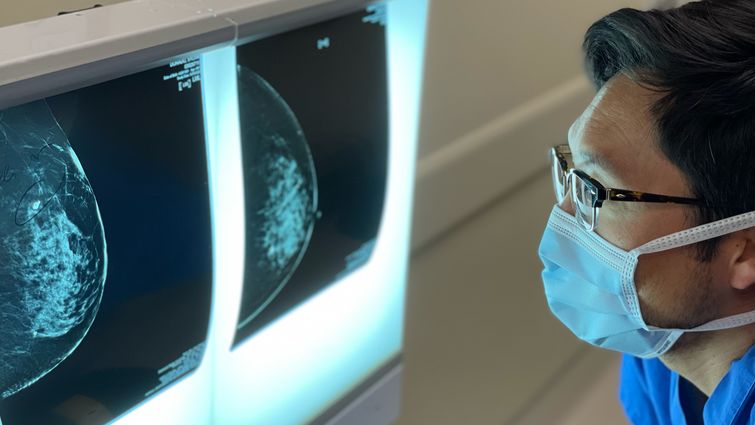
Jukes Namm, MD, assesses a patient's scan results and is familiar with the 'scanxiety,' many patients feel throughout this process. Namm discusses the common survivorship challenge and offers tips to help manage the distress.
Nearly 17 million people in the US who have been diagnosed with cancer are cancer survivors, according to the National Cancer Institute. While some survivors have experienced the relief of completing active cancer treatment, they may now face new hurdles in the next phase of their cancer journey.
A spike in anxiety as yearly scans approach, dubbed “scanxiety,” is one such common survivor challenge. This Cancer Survivor’s Month, Jukes Namm, MD, a surgical oncologist at the Loma Linda University Cancer Center, discusses scanxiety’s roots and resources for coping with the distress.
“Our former cancer patients can face new struggles, questions, and concerns after ending treatment,” Namm says. “The Cancer Center care team supports patients throughout their entire survivorship journey, meaning the rest of their lives if need be.”
As a Quality Accredited Cancer Program by the American College of Surgeons (ACS) Commission on Cancer, LLU Cancer Center provides comprehensive cancer care spanning screening and diagnosis to multi-disciplinary care and treatment, and, importantly, survivorship. Namm says the Cancer Center’s survivorship program encompasses a multi-disciplinary care committee dedicated to promoting wholeness through nutrition, physical therapy or rehabilitation, psychology and therapy, and support groups.
Many patients who finish treatment can return to the “new normal” of their lives in mental, emotional, and physical capacities, Namm says. But a particular time of year may throw the balance askew as routine scans approach.
Because cancer survivors are at increased risk of developing cancer, Namm says they must undergo routine surveillance to monitor for cancer. He says that if the cancer recurs, care teams can swiftly respond to the cancer at an early stage, which could significantly impact outcomes.
“Naturally, when it is time for those scans again, patients’ anxiety can jump up as they worry about whether it has come back,” he says. “I make sure patients receive the news as soon as possible. Usually, it is good news that allows them to breathe a sigh of relief and look forward to another peaceful year free of cancer.”
Though scanxiety is a normal reaction to a stressful event for survivors, Namm says a few tips and approaches can help patients cope with the anxiety as best as they can.
The main message Namm imparts for cancer survivors with scanxiety is to focus on the factors of their lives they can control; there are many ways to do so.
“I always tell patients that in life, and especially in cancer, there are things you can control, but there are also things you cannot control, like genetics, environmental issues, and stressors,” Namm says. “But there are scientifically proven ways to decrease your risk of future cancer by focusing on what you can control such as engaging in mental and physical self-care.”
The Cancer Center's survivorship program offers support in any capacity a patient needs, Namm says. For example, patients can connect with a nutritionist to learn about maintaining a healthy diet as easily as they can speak with a psychologist to prioritize their well-being. In addition, social workers can help with financial hardships or transport. The Cancer Resource Center also provides prostheses, wigs, support groups, and other resources.
“Many patients may not even realize all that is available to them throughout their survivorship,” Namm says. “I always tell them, ‘just ask.’”
Besides focusing on controllable lifestyle factors that reduce the likelihood of cancer recurrence to ease scanxiety, patients can also gain a sense of comfort and control from understanding timelines and expectations of future medical appointments, Namm says. At the Cancer Center, nurse navigators accompany survivors from diagnosis to post-treatment; they keep track of appointments, provide reminders, and remain available for any questions or concerns.
Typically, after survivors reach a milestone of five years of clear, cancer-free scans post-treatment, there is a much lower chance that cancer will recur. Namm says after the milestone, survivors no longer need to maintain the frequency of contact with their cancer care team as they once did.
“Hopefully, survivors can approach that phase with happiness and excitement,” Namm says. “But I remind them that we aren’t going anywhere. If cancer survivors need anything, they know to give us a call, and we are happy to see them."
Namm says he celebrates survivorship with individual patients every day, but Cancer Survivor’s Month prods everyone to pause and acknowledge successful or ongoing battles against cancer. Patients' strength and willpower, paired with constant advancements in cancer care, are a reason for celebration, Namm says.
“One of the most enjoyable parts of my job is seeing a patient in the survivorship phase,” Namm says. “Most of the time, I can ease their anxiety with the good news of clear scans and hear how they and their family are doing. It’s like meeting an old friend.”
The Loma Linda University Cancer Center offers patients comprehensive care that gives them the best opportunity to beat cancer and thrive afterward. To learn more about resources offered at the Cancer Center, visit lluh.org/cancer-center or call 1-800-782-2623.
